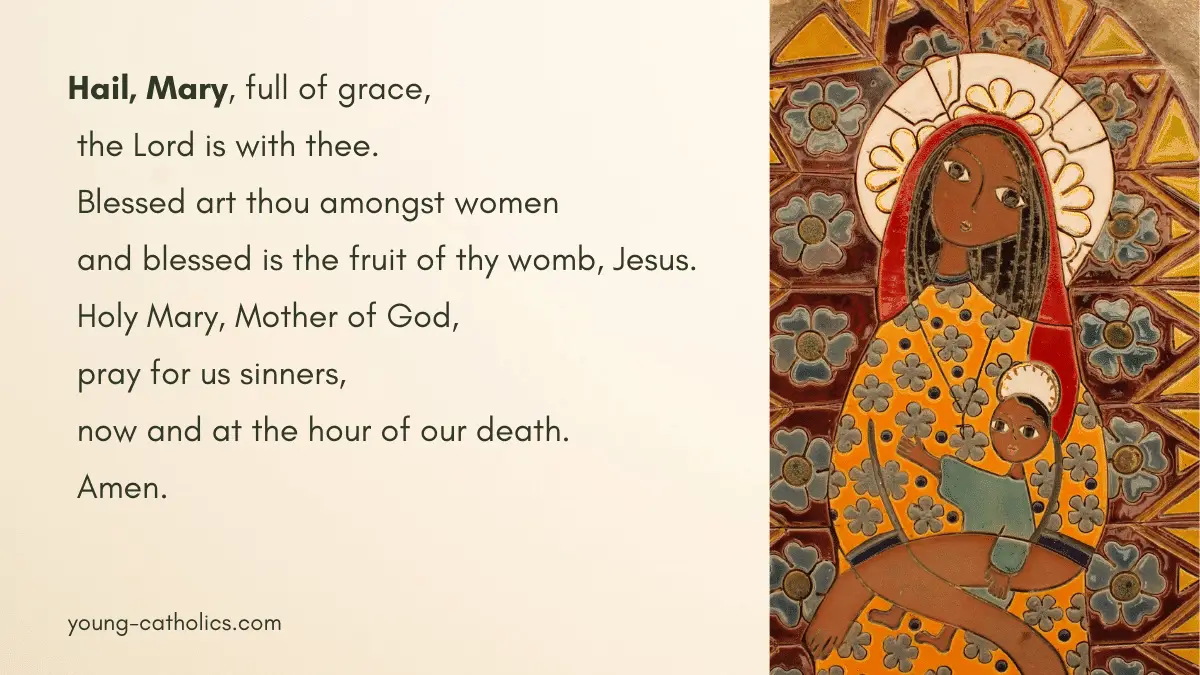The Hail Mary Prayer

The Hail Mary is a simple and powerful prayer that Catholics use to honor Mary, the mother of Jesus. It is a prayer of praise and a request for her to pray for us. The words come mostly from the Bible, showing Mary’s special role in God’s plan. This prayer helps us remember how much God has blessed Mary.
Many people misunderstand the Hail Mary, thinking that Catholics worship Mary. But this is not true. Catholics do not worship her; they only ask for her prayers. Mary is a humble servant of God. She always points us toward her Son, Jesus.
The prayer itself is divided into two parts. The first part comes from the words of the Angel Gabriel and Mary’s cousin Elizabeth in the Gospel of Luke. The second part is a request, asking Mary to pray for us, especially at the moment of our death.
The Hail Mary helps Catholics grow closer to Jesus by reflecting on His mother’s role in His life. It is a reminder that Mary is always ready to help us by praying for us, just like any good mother would.
Based on Scripture
The first part of the prayer echoes the visit from the angel Gabriel, and is completely from scripture.
- “Hail Mary, full of grace” comes from the greeting of the Angel Gabriel in Luke 1:28 – “Hail full of grace”.
- “The Lord is with you” also comes from this encounter in Luke 1:28 -“The Lord is with you.”
The middle part repeats Elizabeth’s greeting to her. This is also found in scripture in the passage on the Visitation.
- “Blessed are you among women” comes from the visitation to Elizabeth in Luke 1:41 – “Blessed are you among women”.
- “And Blessed is the fruit of your womb Jesus” is also from the visitation in Luke 1:42 – “and blessed is the fruit of your womb”,
The end asks Mary to pray for us, as a mother prays for her child.
- “Holy Mary, Mother of God” because Elizabeth recognizes Mary as the mother of the Lord in Luke 1:43 – “And why is this granted me, that the mother of my Lord should come to me?”.
- “Pray for us sinners, now and at the hour of our death” because we would like Mary to pray for us, much as we ask our other fellow Christians to do this. Praying for each other is advised in James 5:16 – “Therefore confess your sins to one another, and pray for one another, that you may be healed. The prayer of a righteous man has great power in its effects”.
So the first part of this prayer echoes the visit from the angel Gabriel. The middle part repeats Elizabeth’s greeting to her. And in conclusion, we ask our Blessed Mother to pray for us, just as we might ask a relative or friend to do.
The History and Structure of the Hail Mary
The Hail Mary prayer has developed over many centuries. It began with simple greetings taken from the Bible. In the early Church, Christians would often recite these phrases from the Gospels as a way to honor Mary. The words “Hail, full of grace, the Lord is with you” were spoken by the Angel Gabriel. Elizabeth’s words, “Blessed are you among women, and blessed is the fruit of your womb,” were added later. These words became part of Christian devotion to Mary.
In the Middle Ages, Christians began adding the second half of the prayer. The request for Mary to “pray for us sinners, now and at the hour of our death” became popular during this time. This addition was a way for Christians to ask Mary for help and protection. By the 14th century, the Hail Mary prayer took the form we know today.
The prayer is divided into two parts. The first part praises Mary, using the words of the Angel Gabriel and Elizabeth. This shows respect for Mary’s role as the mother of Jesus. The second part is a simple request for Mary to pray for us, especially when we are near death. Catholics believe that Mary, as a loving mother, is always ready to pray for us.
The Hail Mary is often repeated in prayer, especially in the Rosary. In the Rosary, we meditate on the life of Jesus while reciting the Hail Mary. This repetition helps us to focus on Jesus while asking for Mary’s prayers.
The prayer has been used in many ways throughout history. Saints, monks, and regular Christians have used it in daily prayer, during Mass, and in times of trouble. The Hail Mary has become one of the most well-known and loved prayers in the Catholic Church.
Catholics of all ages pray the Hail Mary. It continues to connect people to Mary and reminds them of her role in the story of Jesus. Through this prayer, Catholics ask Mary to bring their needs to Jesus, her Son.
A Tool for Teaching
The Hail Mary prayer is deeply connected to themes from the Bible. It reminds us of the events in the Gospel of Luke, where Mary is chosen to be the mother of Jesus. This connects the prayer to the themes of faith, humility, and obedience to God. Mary’s humble acceptance of God’s will is a model for Christians to follow. By praying the Hail Mary, we reflect on these important biblical lessons.
This prayer is also a powerful tool for teaching in Catholic catechesis. It helps teach the importance of asking for help from others in prayer. As Catholics, we are encouraged to pray for one another. This is seen in the Bible, especially in the Book of James, which teaches that “the prayer of a righteous person has great power.” Mary is the most righteous of all humans, as she was chosen to bear Jesus. This makes her prayers especially powerful.
For youth ministry, the Hail Mary is an accessible and easy prayer to learn. It teaches young Catholics how to honor Mary while also asking for her intercession. The simplicity of the prayer makes it perfect for introducing children to the practice of prayer. In youth groups, leaders can use this prayer to show how Mary leads us closer to Jesus. She is not the final goal but the one who helps guide us to her Son.
The Catechism of the Catholic Church also explains why we ask Mary to pray for us. It says, “From the most ancient times the Blessed Virgin has been honored with the title of ‘Mother of God,’ to whose protection the faithful fly in all their dangers and needs” (CCC 971). This teaching shows how Mary’s role as our spiritual mother is important in the Church. She watches over us and prays for us, just like a loving mother would.
In teaching young Catholics, the Hail Mary can be connected to themes of family and community. Just as we ask our parents and friends to pray for us, we ask Mary to pray for us. This makes the prayer relatable for young people and helps them understand the importance of community in faith.
Through youth ministry, the Hail Mary can help young Catholics grow in their relationship with Jesus. By focusing on Mary’s role in the life of Jesus, youth are encouraged to see Mary as someone who helps them in their spiritual journey. This prayer becomes a way for them to deepen their faith and learn the value of prayer in everyday life.
The Prayer
Hail, Mary, full of grace,
the Lord is with you.
Blessed are you among women
and blessed is the fruit of your womb, Jesus.
Holy Mary, Mother of God,
pray for us sinners,
now and at the hour of our death.
Amen.
More Resources

More Catholic Prayers
If you would like to explore more Catholic prayers, visit our Catholic Prayers page at Young Catholics. You will find a collection of traditional prayers, including the Hail Mary, the Our Father, and many others. These prayers can help you grow in your faith and strengthen your relationship with God. Whether you are new to prayer or looking to deepen your practice, this page has something for everyone. Visit today and discover the beauty and power of prayer in the Catholic tradition.
Social Media Graphics
Questions and Answers about the Hail Mary Prayer
What is the Hail Mary prayer?
The Hail Mary prayer is a Catholic prayer that asks the Blessed Virgin Mary to pray for us. It is divided into two parts: the first part comes from the Bible, and the second part is a request for Mary to pray for us.
Is the Hail Mary prayer worship of Mary?
No, the Hail Mary prayer is not worship. Catholics honor Mary and ask for her prayers, but worship is for God alone. The Hail Mary prayer is like asking a friend to pray for you.
Where does the Hail Mary prayer come from?
The first part of the Hail Mary prayer comes from the Gospel of Luke in the Bible. The angel Gabriel and Elizabeth, Mary’s cousin, spoke these words to her. The second part was added later by the Church.
Why do Catholics pray the Hail Mary prayer?
Catholics pray the Hail Mary prayer to honor Mary and to ask for her prayers. They believe that as the mother of Jesus, Mary can help bring their prayers to her Son.
Can anyone pray the Hail Mary prayer?
Yes, anyone can pray the Hail Mary prayer. It is a simple prayer that asks for help from Mary, who is the mother of all Christians. It can be prayed by people of all ages and backgrounds.
Is the Hail Mary prayer only for Catholics?
The Hail Mary prayer is part of Catholic tradition, but anyone who wants to ask Mary for prayers can use it. It is especially popular in the Catholic Church, but other Christians may also find meaning in it.
Conclusion
The Hail Mary prayer is a well-known Catholic prayer that honors the Blessed Virgin Mary. The first part of the prayer comes from the Bible, using words spoken by the Angel Gabriel and Elizabeth, the mother of John the Baptist. These words show Mary’s special role as the mother of Jesus.
The second part of the Hail Mary prayer asks Mary to pray for us, especially at the time of our death. Catholics believe that Mary, as Jesus’ mother, will bring their prayers to Him. The prayer reflects a deep respect for Mary and her connection to Jesus.
This prayer is often said as part of the Rosary, a special set of prayers in the Catholic Church. It is simple and can be said by anyone, at any time. The Hail Mary is a reminder that Mary is always ready to pray for us and help guide us closer to her Son.
Your Turn
Have you prayed the Hail Mary before? We would love to hear your thoughts. Share your experience with the Hail Mary prayer in the comment section below. Whether you pray it daily or are just learning, your story can inspire others. Let’s talk about how this prayer has been a part of your faith journey!




Leave a Reply